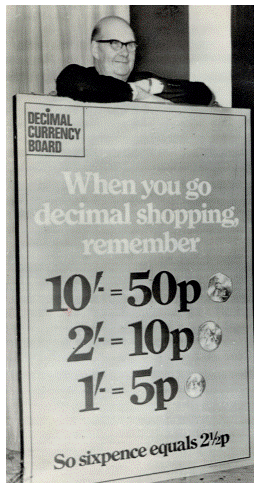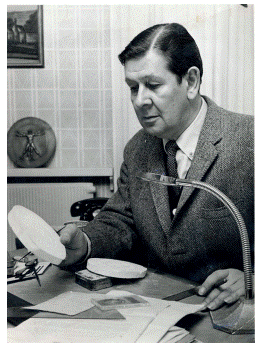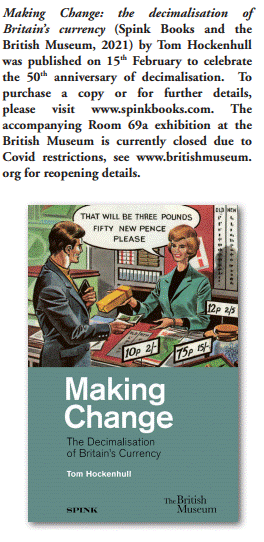On 15th February 1971, ‘D-Day’, the UK went decimal. The pound stayed the same, but the number of pennies in the £ was now 100, from 240 previously, a ratio that had been fixed for more than a millennium. Decimalisation remains the biggest single adjustment to sterling in its history.
Planning had commenced under Selwyn Lloyd, Chancellor of the Exchequer, in July 1960. More enthusiastic about decimalisation than his predecessors, Lloyd set up a working party comprising officials from the Treasury, Royal Mint, Board of Trade, Post Office and the Bank of England, all of whom came out in favour of decimalisation. This was followed by a Cabinet decision in November 1961 to appoint a Committee of Inquiry chaired by Lord Halsbury. The Halsbury Committee advised on the most practical form the currency could take, the timing of its introduction and an estimate of the costs. It reported in 1963, yet government turmoil delayed a public announcement and it would be a further three years before the Labour Chancellor James Callaghan made an official announcement to Parliament, on 1st March 1966. As he admitted, ‘[t]he cost of going decimal is heavy, but you recover it within a year or two and from then on you get a permanent bonus all the way through’.
The Royal Mint had not been idle. Prior to publication of the Halsbury Report it wrote to various arts bodies inviting them to form teams that would compete against one another to produce new decimal designs. Three teams were formed: RIBA, the Royal Academy and a third combined team comprising the Royal College of Art and Royal Designers for Industry (RCA/ RDI). The RCA/RDI team, it is fair to say, was the only one that acted like a team. RIBA put forward only two designers while the Royal Academy’s efforts were stifled by its President, Sir Charles Wheeler, who appears to have harboured ambitions of his own to win the competition. On the RCA/RDI team the designer Geoffrey Clarke’s ideas were particularly experimental (Fig 1). He proposed dish-shaped coins and designs where all the textual information is restricted to one side. They were, however considered overly adventurous, and taken no further.
Also on the RCA/RDI team, Christopher Ironside’s ideas were more promising, and he was invited to progress them for the decimal reverses. Meanwhile, overlooking Wheeler’s efforts, the Royal Mint Advisory Committee (RMAC) selected Arnold Machin from the Royal Academy to sculpt a new portrait of the Queen (Wheeler would get his revenge by taking the £300 in prize money for himself!). Machin recounts in his autobiography how he was granted four sittings with the Queen in an upstairs room at Buckingham Palace. One final sitting took place at Balmoral Castle where the Royals were spending the Summer break. While there he was given a tour of the estate and invited to a special dinner celebrating the announcement that the Queen was expecting a fourth child. His portrait, which replaced Mary Gillick’s coronation portrait, first featured on the new decimal coinage of Australia from 1966.
A first set of reverses was completed by Ironside between 1963 and 1966. Their development was not without difficulty. A design for the 2p featuring Britannia proved particularly problematic, and was the last to gain approval from the RMAC, prior to being shown to Cabinet ministers in July 1966 (Fig 2).
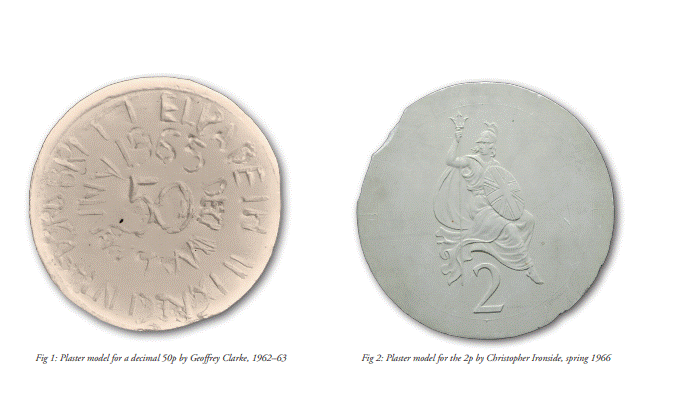
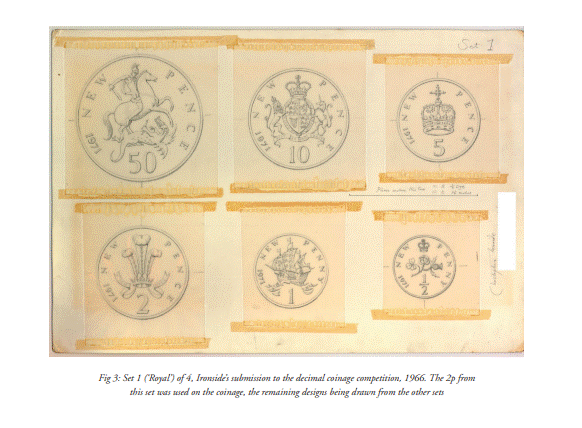
Their response was less than enthusiastic with one particularly vocal critic describing them as ‘bad, fussy and “old hat”’. This was a huge blow to the Mint. Feeling that the role of the RMAC had been undermined, the Duke of Edinburgh briefly contemplated resigning as its President. Instead, in August 1966, he wrote to the Chancellor suggesting if ministers didn’t like them, perhaps a public competition could be held to find fresh designs. Ironside was summoned to the Mint where the Deputy Master, Jack James, poured him a large gin and tonic and broke the calamitous news. After a few days’ despair, Ironside resolved that he must enter the open competition with a fresh set of designs, so he went back to the drawing board, emerging with four sets: Royal (Fig 3), Regional and Popular, deciding at the last minute to add a fourth ‘Avant-Garde’ set.
More than eighty submissions were received from established artists and members of the public and, as might be expected, they varied enormously in quality. It was clear, though, that one set of designs stood clear above any other: those by Ironside. Had he not prevailed for a second time, his role in the decimal coinage would be little more than an unfortunate footnote. Writing from the Palace in January 1967, Prince Philip said that:
‘In the course of discussion it turned out that the “Prince of Wales feathers” [favoured by the Committee] was designed by Ironside and he had also done a design incorporating the “Portcullis” which is the badge associated with Westminster and used by Members of Parliament.’
With the competition won, Ironside’s decimal reverses quickly fell into place – the crest of England on the 10p, badge of Scotland on the 5p and badge of the Prince of Wales on the 2p. A set of drawings from early 1967 shows the designs close to being finalised, apart from the 50p (Fig 4). Following feedback from the RMAC the chains on the portcullis on the 1p were straightened, the lion’s tail on the 10p was thickened at the base and, at the insistence of Prince Philip, a crown was added to the thistle on the 5p. Ironside had originally proposed that the portcullis motif associated with Parliament should sit on the ½p (Fig 5). However, since the ½p was looking likely to be later withdrawn owing to inflation, its design was considered the least important of the set. The decision was taken to transfer the portcullis onto the 1p coin while a more expendable design – a royal crown was introduced on the ½p. The Mint was later alerted to a minor error in the portcullis design, specifically in the crown of Henry VII above where the cross pattée and not the fleur-delys should come by the arches. The same error had been made on the sixteenth century gates of Westminster chapel, which is possibly where Ironside saw and copied it. Nobody else had seemed to notice, and so the Mint remained quiet.
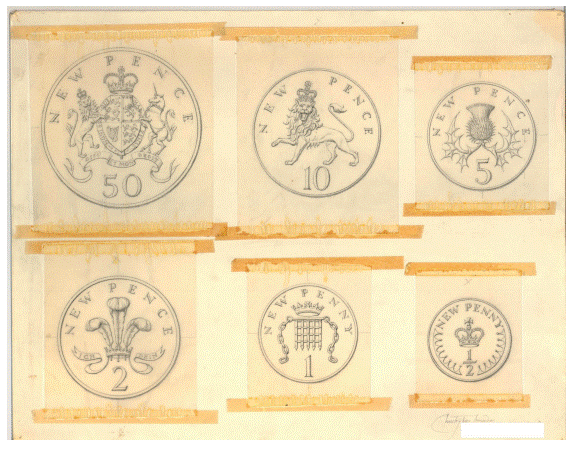


The 50p was the last to be formalised, its development rendered more complex owing to its unusual shape, a trochoid heptagon, with rounded edges so that it wouldn’t get stuck in vending machines. It was initially intended to feature a Royal Coat of Arms (which did eventually crop up on a commemorative 50p in 2013), but an outcry over the omission of Britannia when the other coins were announced in March 1968 prompted a rethink. Ironside revived one of his Britannia designs from the competition – famously modelled on his wife, Jean holding a ruler instead of a trident. This was adapted to the seven-sided shape of the new coin, which went into circulation in 1969 (Fig 6). The 5p and 10p coins had gone into circulation from 1968, interchangeable with the one and two-shilling coins. The copper decimals were issued from D-Day.
The logistical implications of decimalisation were enormous. To satisfy production demands the Royal Mint had to move its operations from its cramped, outdated factory on Tower Hill to a new facility at Llantrisant. Meanwhile, the UK’s estimated 610,000 cash registers all had to be made decimal-ready. The conversion of equipment came at a cost which had to be borne by the retailer. With new machines costing about £100, most elected to have their existing machines converted, at a cost of £30– 40. Planning had commenced years in advance and parts had been stockpiled. The task fell to teams of technicians employed by the big manufacturers who worked fifty or even sixty hour weeks from January to October 1971. The National Cash Register Company alone employed 1,600 technicians to complete the job. Meanwhile, shops carried out extensive staff training. In Croydon, Sainsbury’s converted one of its stores into a decimal shop which it used to train staff and to host groups from various women’s organisations (Fig 7).
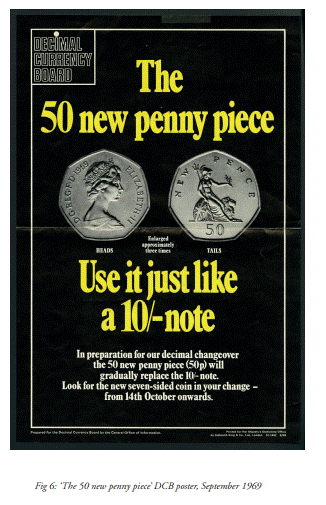

The transition was overseen by the Decimal Currency Board (DCB), chaired by Bill Fiske (Fig 8) and staffed by fifty civil servants based at an office in Whitehall. It coordinated the marketing and education campaign, posting a copy of Your Guide to Decimal Money to every UK household. Posters advertised the introduction of the new coins, as well as the withdrawal of the old ones. In the weeks running up to D-Day the Board practically took over the commercial TV networks, occupying an unprecedented 1244 ad-break slots. Topical mentions were inserted to the storylines of Coronation Street and The Archers while a half hour ITV drama Granny Gets the Point, starring Doris Hare, was broadcast repeatedly. Regular public surveys were conducted and the results fed back in to ensure a reactive campaign.
Bill Fiske famously declared that D-Day would be the non-event of 1971. By and large, he was right. February had been chosen for the changeover because it was the least inconvenient time of the year – a quiet day for businesses and banks. Banks had, in fact, been closed since the end of Wednesday 10th February, giving them four days to prepare – an inconvenience for customers that was offset slightly by a recent innovation to the high street: the cashpoint. A survey commissioned by the DCB on the day found that 67 per cent of those interviewed found shopping easy, 25 per cent found it hard and 8 per cent had no feelings either way. Crucially, of those interviewed, 73 per cent said it would get easier over time. Newspapers were quick to declare that D-Day had been a success: ‘You’re getting the point’, said London’s Evening Standard. Swift public acceptance of the new coins and system enabled the transition period (when old and new money could circulate together) to be reduced from eighteen months to six. The DCB’s activities were quickly scaled back and it was formally wound up in 1972.
Christopher Ironside’s drawings and plaster models for the coins are now held in the British Museum. Fifty years on, as D-Day recedes in the public memory, they are heralded as classic examples of good design:
‘I was not designing for myself’, he explained, ‘but for everyone else’ (Fig 9).
